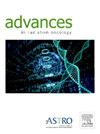Comparative Outcomes of Standard Radiation Therapy and 5-Fraction Adaptive Stereotactic Radiation Therapy in Newly Diagnosed Glioblastoma: A Propensity Score–Matched Analysis
IF 2.7
Q3 ONCOLOGY
引用次数: 0
Abstract
Purpose
Glioblastoma multiforme (GBM) is the most common and aggressive primary brain tumor in adults, with poor survival despite advancements in treatment. Adaptive stereotactic radiation therapy (RT) using a magnetic resonance imaging linear accelerator is an emerging approach for patients with newly diagnosed GBM eligible for conventional fractionation. We hypothesize that adaptive stereotactic RT can provide comparable outcomes with conventional fractionation while reducing treatment burden.
Methods and Materials
We retrospectively reviewed 96 adults with newly diagnosed GBM treated at our institution between 2018 and 2024. Inclusion criteria included the age of 18 years, confirmed GBM diagnosis, and completed treatment. Patients with prior brain irradiation or incomplete treatment were excluded. Propensity score matching was performed to balance demographics, tumor characteristics, and treatment protocols across 5-fraction, 15-fraction, and 30-fraction groups. Statistical analyses included the Fisher exact test, Mann-Whitney U test, Cox proportional hazards models, and Kaplan-Meier survival curves.
Results
After propensity score matching, 17 pairs were matched for 5 versus 30 fractions and 14 pairs for 5 versus 15 fractions. Median overall survival was 21.1 versus 18.2 months (5 vs 15 fractions, P = .77) and 11.7 versus 14.6 months (5 vs 30 fractions, P = .5). Median progression-free survival was 9.0 versus 7.9 months (5 vs 15 fractions, P = .89) and 8.9 versus 9.7 months (5 vs 30 fractions, P = .97). Local failure and grade 3 toxicity rates were similar across groups. O6-methylguanine-DNA-methyltransferase unmethylated status, higher Eastern Cooperative Oncology Group scores, and age 60 years were associated with worse progression-free survival and overall survival. Median travel distances were lower in the 5-fraction group, with a median of 220 miles compared with 877.5 (15 fractions) and 1638 miles (30 fractions). Adaptive RT allowed for real-time tumor monitoring but volumetric changes did not correlate with clinical outcomes.
Conclusions
Adaptive 5-fraction RT demonstrates comparable survival outcomes with conventional fractionation while reducing treatment-related travel burden. Further prospective studies are needed to validate its role in GBM management.
新诊断的胶质母细胞瘤的标准放射治疗和5分次适应性立体定向放射治疗的比较结果:倾向评分匹配分析
目的多形性胶质母细胞瘤(GBM)是成人中最常见和侵袭性的原发性脑肿瘤,尽管治疗取得了进步,但其生存率很低。使用磁共振成像直线加速器的适应性立体定向放射治疗(RT)是一种新兴的方法,适用于新诊断的GBM患者。我们假设适应性立体定向放射治疗可以提供与传统分割相当的结果,同时减少治疗负担。方法和材料我们回顾性分析了2018年至2024年间在我院治疗的96例新诊断的GBM成人患者。纳入标准为年龄18岁,确诊为GBM,完成治疗。排除既往脑照射或未完全治疗的患者。在5分、15分和30分组中进行倾向评分匹配,以平衡人口统计学、肿瘤特征和治疗方案。统计分析包括Fisher精确检验、Mann-Whitney U检验、Cox比例风险模型和Kaplan-Meier生存曲线。结果倾向评分匹配后,5分与30分匹配17对,5分与15分匹配14对。中位总生存期分别为21.1个月对18.2个月(5个对15个分数,P = 0.77)和11.7个月对14.6个月(5个对30个分数,P = 0.5)。中位无进展生存期为9.0个月vs 7.9个月(5个组对15个组,P = 0.89), 8.9个月vs 9.7个月(5个组对30个组,P = 0.97)。各组间局部失败率和3级毒性率相似。o6 -甲基鸟嘌呤- dna -甲基转移酶未甲基化状态、较高的东部肿瘤合作组评分和60岁与较差的无进展生存期和总生存期相关。5分组的中位数旅行距离较低,为220英里,而877.5英里(15分)和1638英里(30分)。适应性放疗允许实时肿瘤监测,但体积变化与临床结果无关。结论适应性5分步放疗与常规分步放疗相比,在减少治疗相关的旅行负担的同时,显示出相当的生存结果。需要进一步的前瞻性研究来验证其在GBM管理中的作用。
本文章由计算机程序翻译,如有差异,请以英文原文为准。
求助全文
约1分钟内获得全文
求助全文
来源期刊

Advances in Radiation Oncology
Medicine-Radiology, Nuclear Medicine and Imaging
CiteScore
4.60
自引率
4.30%
发文量
208
审稿时长
98 days
期刊介绍:
The purpose of Advances is to provide information for clinicians who use radiation therapy by publishing: Clinical trial reports and reanalyses. Basic science original reports. Manuscripts examining health services research, comparative and cost effectiveness research, and systematic reviews. Case reports documenting unusual problems and solutions. High quality multi and single institutional series, as well as other novel retrospective hypothesis generating series. Timely critical reviews on important topics in radiation oncology, such as side effects. Articles reporting the natural history of disease and patterns of failure, particularly as they relate to treatment volume delineation. Articles on safety and quality in radiation therapy. Essays on clinical experience. Articles on practice transformation in radiation oncology, in particular: Aspects of health policy that may impact the future practice of radiation oncology. How information technology, such as data analytics and systems innovations, will change radiation oncology practice. Articles on imaging as they relate to radiation therapy treatment.
 求助内容:
求助内容: 应助结果提醒方式:
应助结果提醒方式:


